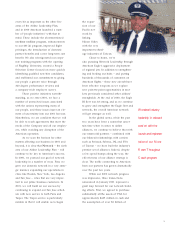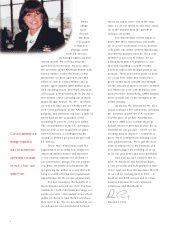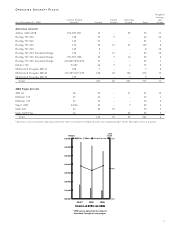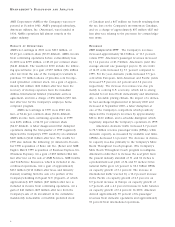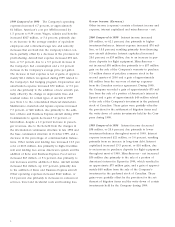American Airlines 2000 Annual Report Download - page 14
Download and view the complete annual report
Please find page 14 of the 2000 American Airlines annual report below. You can navigate through the pages in the report by either clicking on the pages listed below, or by using the keyword search tool below to find specific information within the annual report.
12
No. 121, “Accounting for the Impairment of Long-Lived
Assets and for Long-Lived Assets to Be Disposed Of.”
This review could result in an impairment charge to
be taken by the Company in 2001. The size of any
resulting 2001 charge is not presently known, but
may be significant.
FORWARD-LOOKI NG INFORM ATI ON
The preceding Letter to Shareholders, Customers and
Employees and Management’s Discussion and Analysis
contain various forward-looking statements within the
meaning of Section 27A of the Securities Act of 1933,
as amended, and Section 21E of the Securities Exchange
Act of 1934, as amended, which represent the Com-
pany’s expectations or beliefs concerning future events.
When used in this document and in documents incor-
porated herein by reference, the words “expects,”
“plans,” “anticipates” and similar expressions are
intended to identify forward-looking statements.
Forward-looking statements include, without limita-
tion, expectations as to results of operations and
financial condition, including changes in capacity,
revenues and costs, expectations as to future financ-
ing needs, overall economic projections and the
Company’s plans and objectives for future operations,
including its ability to successfully integrate into its
operations assets the Company may acquire in its previ-
ously announced transactions with TWA, United/US
Airways and DC Air, and plans to develop future code-
sharing programs and to evaluate new alliances. All
forward-looking statements in this report are based
upon information available to the Company on the date
of this report. The Company undertakes no obligation
to publicly update or revise any forward-looking
statement, whether as a result of new information,
future events or otherwise. Forward-looking statements
are subject to a number of factors that could cause
actual results to differ materially from our expectations.
The following factors, in addition to other possible
factors not listed, could cause the Company’s actual
results to differ materially from those expressed in
forward-looking statements: uncertainty of future
collective bargaining agreements and events; economic
and other conditions; commodity prices; competition in
the airline industry; changing business strategy; govern-
ment regulation; uncertainty in international operations;
and industry consolidation. Additional information
concerning these and other factors is contained in the
Company’s Securities and Exchange Commission filings,
including but not limited to Form 10-K for 2000, copies
of which are available from the Company without
charge.
MARK ET RISK SENSIT I VE IN STRUM ENT S
AND POSITIONS
The risk inherent in the Company’s market risk sensi-
tive instruments and positions is the potential loss aris-
ing from adverse changes in the price of fuel, foreign
currency exchange rates and interest rates as discussed
below. The sensitivity analyses presented do not con-
sider the effects that such adverse changes may have
on overall economic activity, nor do they consider
additional actions management may take to mitigate
its exposure to such changes. Actual results may differ.
See Note 6 to the consolidated financial statements for
accounting policies and additional information. In addi-
tion, the following analyses exclude any impact of the
proposed transactions discussed on pages 9 and 10.
Aircraft Fuel The Company’s earnings are affected by
changes in the price and availability of aircraft fuel. In
order to provide a measure of control over price and
supply, the Company trades and ships fuel and main-
tains fuel storage facilities to support its flight opera-
tions. The Company also manages the price risk of
fuel costs primarily utilizing swap and option contracts.
Market risk is estimated as a hypothetical 10 percent
increase in the December 31, 2000 and 1999 cost per
gallon of fuel. Based on projected 2001 fuel usage,
such an increase would result in an increase to air-
craft fuel expense of approximately $194 million in
2001, net of fuel hedge instruments outstanding at
December 31, 2000. Comparatively, based on projected
2000 fuel usage, such an increase would have resulted
in an increase to aircraft fuel expense of approximately
$131 million in 2000, net of fuel hedge instruments out-
standing at December 31, 1999. The change in market
risk is due primarily to the increase in fuel prices. As of
December 31, 2000, the Company had hedged approxi-
mately 40 percent of its 2001 fuel requirements, approx-
imately 15 percent of its 2002 fuel requirements, and
approximately seven percent of its 2003 fuel require-
ments, compared to approximately 48 percent of its
2000 fuel requirements and 10 percent of its 2001 fuel
requirements hedged at December 31, 1999.



